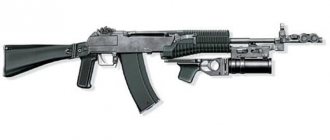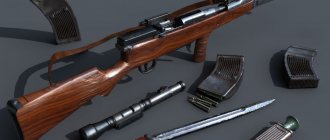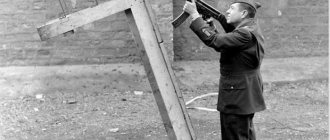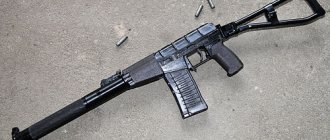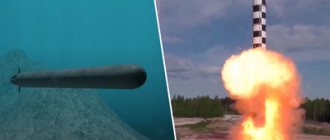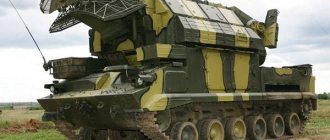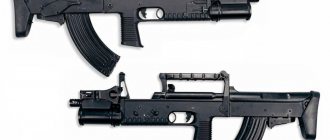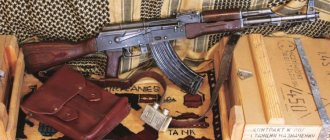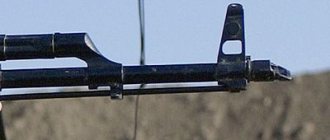Military sniper complex VSK-94
The VSK-94 military sniper complex, built on the basis of the 9A91 assault rifle, incorporates all the best that could be taken from its predecessor - light weight, traditional reliable design and proven subsonic ammunition of 9x39mm caliber.
If almost nothing is known about the use of VSK-94 by special forces units during the first Chechen campaign, then in the second Chechen campaign all the silent weapons that the Russian army then possessed showed their best side.
In 1995, the Tula Instrument Design Bureau, as part of a family of weapons created on the basis of the 9A-91 “Val” assault rifle, designed a “silent” 9-mm automatic sniper rifle VSK-94 (Military Sniper Complex, index GRAU 6B8). With the VSK-94 rifle you can use SP5, SP6, PAB-9 cartridges. The heavy low-velocity bullet of the PAB-9 cartridge penetrates an 8 mm thick steel plate at a distance of 100 m.
VSK-94 was previously used in special forces of law enforcement agencies as a weapon for covert destruction of enemy personnel, including those using personal armor protection and unarmored objects at a range of up to 400 m. In 2002, VSK-94 was adopted by the army. The VSK-94 automatic weapon has a gas engine and operates according to a scheme with a long stroke of the gas piston (the gas piston is rigidly connected to the bolt frame). To give the piston rod the required length, the gas chamber is extended forward from the gas outlet of the barrel. The barrel bore is locked by turning the bolt with four lugs.
The bolt carrier has a folding charging handle. The trigger (unlike the VSS rifle) trigger mechanism allows for single and automatic fire. The non-automatic translator safety is of the flag type; its flag is mounted on the left side and has an almost inaudible (compared to, for example, AKM or SVD) click. When the safety is turned on, the flag blocks the groove for the reloading handle to pass through. The cartridges are fed from a double-row detachable box magazine with a staggered arrangement of cartridges. Magazines with a capacity of 10 or 20 rounds can be used.
When using a 20-round magazine, the effect of ammo consumption on the balance of the weapon is reduced. The declared accuracy when firing at a distance of 100 m is no more than 10 cm. Due to the ability to fire in bursts and the increased magazine capacity in close combat, the VSK-94 can be used as an assault rifle. The transformation of the 9A-91 assault rifle into a “silent” sniper rifle was accompanied by the installation of a removable silencer, a detachable non-folding frame plastic stock with a rubber shock absorber, made in a single design with a pistol grip.
The VSK-94 silencer significantly reduces the volume of a shot and completely eliminates muzzle flash, allowing you to covertly hit targets at ranges of up to 400 m. The absence of a muzzle flash, in addition to reducing the unmasking signs of a shot, has a positive effect on working with night vision scopes. There are no replaceable elements in the muffler design. In practice, the VSK-94 rifle, of course, is not completely silent - when firing (especially in bursts), the clang of the shutter can be heard quite far away.
The barrel of the VSK-94 sniper rifle is non-chrome plated, this was done to increase accuracy. The “payment” for this solution is worse barrel survivability. The standard side rail on the receiver allows for mounting sights - day sights PKS-07 or night sights developed by KBP (both with an aiming mark in the form of a red dot). The glowing red dot reduces the time it takes to re-aim when shooting while moving the aiming point. When the battery is used up or fails, the red dot of the PKS-07 sight does not disappear, but turns black, and the sight remains operational.
The PKS-07 sight with 7x magnification and a 3-degree field of view has a simple elliptical rangefinder in its field of view - quickly determining the distance to the target is especially important for weapons with low bullet speeds. The PKN-OZM night sight is built on the basis of a second-generation electro-optical converter and allows targeted fire on a moonless cloudy night at a distance of up to 200 m, and in moonlight - up to 350 m. To improve visibility, there is a switchable IR illuminator.
VSK-94 was also demonstrated with the PSO-1-1 optical day sight. The mechanical sight is designed for firing ranges of 100, 200, 300 and 400 m. Like the VSS, the VSK-94 rifle can be easily disassembled for carrying in a special case. Assembling the rifle takes about one minute. The VSK-94 sniper rifle was used during the counter-terrorist operation on the territory of the Chechen Republic, and during combat operations it established itself as an effective, reliable and unpretentious weapon.
In the village of Alkhan-Kala, a combined special forces detachment of the Ministry of Internal Affairs and the FSB carried out an operation during which one of the field commanders of the Chechen militants, Arbi Barayev, was eliminated along with his group. It was in this special operation that the leading role was played not only by special forces soldiers who stormed the militants’ positions, but also by snipers of Russian special forces who worked on the militants’ positions using silent weapons.
Nikolai Rychkov, one of the participants in those events, told in an interview how it happened:
“The work of silent weapons in Chechnya is, it seems to me, a topic for writing a scientific dissertation. So many applications and almost one hundred percent effectiveness. Why almost? Well, because sometimes weather conditions interfered, sometimes the situation did not allow it. Otherwise, the weapon always worked like a clock. As for Barayev’s gang, the snipers whose work I observed were literally crawling along the ground. Later I found out that they were working from VSK-94. The silhouette of the weapon is unusual. The height and overall dimensions are so well thought out that only later, when I personally took this weapon to look at it, I realized that this is the only effect it can give - hitting the target and silence. As far as I remember, the snipers shot out one magazine in total. That is, about twenty rounds each, or even less. And the job was done."
A special role in the liquidation of Barayev’s gang, in addition to the competent actions of special forces and operational intelligence reports, was played by the VSK-94, which was equipped with the usual PSO-1 sniper scope. During this carefully carried out operation, the armor-piercing cartridge SP-6 deserves special mention, with which Russian special forces snipers hit the enemy “covered” by body armor.
In addition to participating in the liquidation of Barayev, the Tula complex had the opportunity to take part in a good dozen operations of the second Chechen campaign. The liquidation of the field commander Movsan Suleimenov, the special operation in Argun, the operation to liberate Urus-Martan... a dozen or even a hundred operations were successfully carried out precisely thanks to silent weapons, and it was the VSK-94 complex that made a great contribution to the overall victory.
The VSK-94 and its predecessor, the 9A91, proved in real combat work that weapons chambered for the 9x39mm cartridge can be much more lethal and useful than conventional sniper and other special weapons. During the fighting, military personnel who had the opportunity to work with Tula weapons noted that the service life of the VSK-94 and 9A91 barrel and the overall survivability and reliability of the design would soon make it possible to almost completely abandon the use of the SVD rifle during special operations.
According to the military, the range of both the earlier 9A91 and the modernized VSK-94 is enough to hit the enemy and guarantee the secrecy of the sniper’s work. One way or another, Tula weapons went through all the stages of silent weapons: from the drawing board to real, harsh operation in battle and in thirty-degree frost and forty-degree heat.
The design engineers of the Tula Design Bureau were once again able to prove in practice that silent sniper weapons are perhaps the main tool for treating the disease called international terrorism.
As for the Tula 9A91 and VSK-94, they have gained well-deserved respect and honor among the military, along with other silent weapons, such as the special VSS sniper rifle and the small-sized VAL assault rifle from TsNIITochmash. The entire range of silent weapons, with minor modifications and improvements, are still used by Russian special forces to this day.
More details here (text source)
Thanks for reading!
In addition, I suggest reading other articles from my blog: CLICK
Steyr Scout Tactical (Austria)
Steyr Scout rifles are manufactured by Steyr, Austria.
The idea of the Scout rifle (scout) was born in the head of the famous American shooter and weapons expert Jeff Cooper. He managed to infect the Steyr company with this idea, and as a result, the company launched the Scout rifle on the market in the late 1990s, based on Steyr’s patented longitudinally sliding rotary bolt design SBS (safety bolt). The main idea of the "Scout" is a lightweight, universal weapon, suitable for hunting at medium distances with medium game (up to 150-200 kg). The "Scout" rifle has a proprietary Steyr cold-forged barrel, a polymer stock, adjustable in length using butt pads. The stock has a built-in lightweight plastic folding bipod, which when folded turns into part of the fore-end. The rifle is equipped with a folding rear sight and front sight, but the main one is a 2.5X optical sight, mounted low above the barrel and with a large offset forward, which provides convenient aiming with both eyes and quick target acquisition. The butt has a slot at the bottom for a spare magazine. Standard 5-round magazines are considered standard, but you can install a special magazine socket extension and use optional 10-round magazines. The safety is three-position, with the modes “fire”, “loading/unloading” (the striker is blocked, the bolt is movable), “safe” (the striker and the bolt are locked). The rifle is very easy to handle and has excellent accuracy, so creating a sniper weapon on its basis rifles was the obvious move.
The Scout Tactical rifle differs slightly from the basic version - it has a blued bolt with an enlarged handle (for ease of quick reloading), and a more traditional optical sight arrangement. In addition, the Scout Tactical often comes with an adapter for a 10-round magazine.
Sniper rifle Heckler - Koch PSG-1 (Germany)
In the mid-80s, Heckler und Koch, in collaboration with various counter-terrorism organizations, including the German GSG9 and the British SAS, created the PSG-1 long-range self-loading sniper rifle. The rifle is based on the standard Bundeswehr HK G3 automatic rifle, and uses the same principle - a semi-free bolt slowed down by rollers. It differs from the G3 in the inability to fire in bursts, a special heavy barrel 650 mm long with polygonal rifling, a modified adjustable buttstock with a cheek rest, an adjustable trigger, a modified sport-style fire control handle and special guides on the receiver for mounting optical sights. In addition, the PSG-1 has a device “for silently closing the shutter” in the form of a button behind the window for ejecting cartridges
Enfield L39A1, L42A1 and Enforcer (UK)
After the end of World War II, a large number of Lee-Enfield SMLE No.4 repeating rifles in .303 British caliber accumulated in England. After the NATO countries adopted the 7.62x51mm cartridge as standard, the British state arms company British Royal Small Arms Factory (RSAF), Enfield, developed an option to convert SMLE No.4 rifles to the new cartridge. Conversion rifles were intended for target shooting and were equipped with a new, heavy 7.62mm NATO caliber barrel and a modified stock with a shortened fore-end and receiver guard. The civilian version was released under the designation Enfield “Envoy” match rifle, and the military version under the designation L39A1 target rifle.
Due to the need to adopt a sniper rifle, the L42A1 rifle was created on the basis of the L39, which was distinguished by the presence of mounts for an optical sight on the left side of the receiver, as well as a wooden “cushion” under the cheek on the butt.
In 1970, based on the L42, Enfield engineers developed a police sniper rifle designated the Enfield "Enforcer". The main differences from the L42 were a modified hunting-type stock with a semi-pistol grip, open adjustable sport-type sights and more modern commercial optical sights than the L42.
The L42 and Enforcer rifles were produced until 1985 and were replaced mainly by the L96 / Arctic Warfare rifles from the British company Accuracy International.
Advantages
- Acceptable muzzle energy.
- High penetration and lethal effect of the bullet.
- The targeted and effective range of fire is quite sufficient for carrying out special operations in open areas. A comfortable stock and an adapted optical sight ensure good shooting accuracy. The absence of a muzzle flash and muffling the sound of a shot allow the sniper to work covertly in close proximity to the enemy.
- A heavy bullet slowly loses kinetic energy, which ensures high lethality, even beyond the maximum range of aimed fire.
- The small vertical size allows the shooter to press tightly to the ground.
- The silencer does not contain replaceable elements, so its effectiveness does not decrease long enough during the shooting process.
- The rifle is resistant to dust and has reliability similar to Kalashnikov assault rifles.
In popular culture
The gun is often mentioned in domestic TV series about airborne troops and special forces.
In the gaming industry, the most striking example is the third-person shooter called “Metro 2033” and the sequel “Metro: Ray of Hope”. The sample in the game is called VSV and is mistakenly called “Vintorez” by many fans of the game. All because of the external similarity, poor knowledge about weapons and passion for the STALKER universe. Although the projects weakly correlate with each other, the themes are still very similar. In addition, in the last mentioned shooter, the Vintar is almost one of the best rifles.
There is no gun in the STALKER game projects, although it was originally planned by the developers. Considering that the same company produced both games, the developers were not left without ideas, and the fans were not left without their favorite weapons.
Airsoft fans also widely use the VSK-94 sniper rifle. The price of the adapted version varies from 37,000 to 65,000 rubles, depending on the country of origin and the body kit that comes with the sample. It is inappropriate to talk about tactical and technical characteristics in this case, because airsoft is a game, it does not pursue the goals of penetrating armor and eliminating enemy manpower.
Instead of a bullet there is a ball of paint, and death is formal. The weapon model was made to suit the realities of the game: a different caliber, a different operating mechanism. Only the appearance remained from the original.
In many books, the heroes are also armed with this rifle. These are mainly paratroopers and special forces, which is quite logical. We are talking about the books of the “Metro Universe” franchise by Dmitry Glukhovsky and STALKER, and if in the first, for the most part, this weapon unit is presented as a makeshift model, then in the second - almost as a freshly unpacked product from the warehouses of the “Dolg” group, which is present in the Zone along with other formations: “Freedom”, “Clear Sky”, “Monolith”, “Mercenaries” and other permanent inhabitants of the mentioned game universe.
Let the war remain only in games, films and literature.
Purpose
This rifle sniper complex (VSK-94) was created to wage covert warfare and defeat enemy infantry. At a distance of up to 400 meters, the body armor is not able to stop a bullet from it. If a shot is fired at a distance of up to 100 meters, then a sheet of steel 8 mm thick breaks through.
In other words, to penetrate an enemy soldier equipped with body armor, you need to get quite close.
Thanks to the design, the shooter’s position is not unmasked: there is no flame, silent shooting, and low ricochet ability. The latter factor ensures high shooting accuracy, especially during hostage rescue operations.
